IDEX Online Research: Jewelry Price Inflation Running Above Average (Full Analysis)
July 22, 10
The wide disparity between retail jewelry price inflation and supplier price inflation that has characterized the jewelry industry since late last year continued in June 2010. However, there were signs that retail price inflation may be headed higher. For the past two months, retail prices have increased between 2-3 percent each month, year-over-year, a rate that is slightly above the 1.8 percent average annual increase over the past two decades.
Several retail chain jewelers have announced price increases during the first and second quarter of 2010, and more retail price increases are on the way, prior to the 2010 holiday selling season.
Jewelry Producer Price Inflation Continues to Rise Sharply
Producer prices for jewelry rose sharply in June by 10.2 percent, when compared to June 2009, driven primarily by higher prices of precious metal jewelry – mostly gold. The Jewelry Producer Price Index as been in the high single-digit range or low double-digit range for all of 2010 as well as the fourth quarter of 2009. Producer prices have risen at double-digit levels for the past four months.
The graph below summarizes the Jewelry Producer Price Index – jewelry price inflation at the supplier level – for the past twenty-four months.
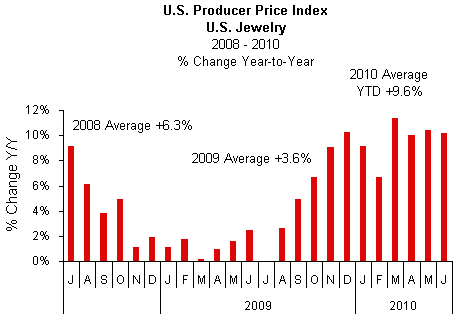 Source: BLS |
While the Jewelry Producer Price Index averaged a very modest +3.6 percent inflation rate in 2009 when demand was soft, it has averaged 9.6 percent for the first six months of 2010. In part, price increases have been implemented by suppliers who want to make up for their inability to raise prices in late 2008 and early 2009 when gold prices were soaring. Due to the recessionary environment in 2008 and 2009, suppliers could not pass along those higher gold prices to their customers.
JPPI Driven By Higher Precious Metals Costs
Precious metals prices have remained high for the past several months. These high prices have pushed supplier prices up, as the goods with high-priced metals have worked their way through the distribution pipeline toward retailers. The graph below compares the JPPI for all jewelry producer prices (red bars) to the JPPI for precious metal jewelry costs (yellow bars).
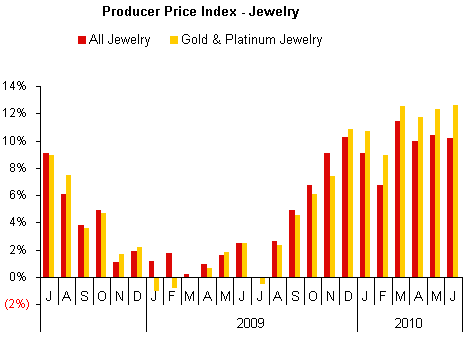
Source: BLS
Producer price inflation for watches had languished just above 1 percent or so for the first three months of 2010, but rose to over 2 percent in April, pulled back to 1.9 percent in May, and held relatively steady at about 1.8 percent in June, as the following graph illustrates.
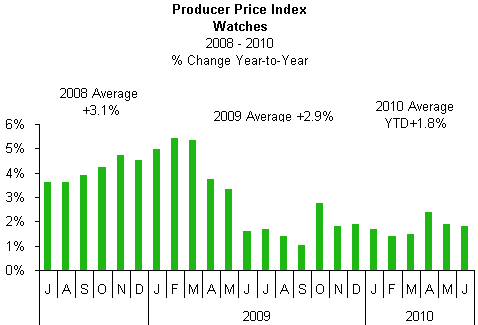
Source: BLS
Jewelry Consumer Price Inflation (JCPI) Remains Modest
Retail prices of jewelry in June, as measured by the JCPI, rose by 2.5 percent, the second highest level in 2010 after May’s +2.9 percent. While retail jewelry price inflation remains modest when compared to suppliers’ price inflation, it is running above its long-term two-decade trend of +1.8 percent.
But retail price inflation for jewelry remains very modest, especially when compared to the JPPI. For the first six months of 2010, the JCPI is up by 1.4 percent, and it has been edging up every month. However, this year-to-date inflation rate for retail jewelry prices remains well below 2009’s average retail jewelry inflation rate of +1.8 percent; it also remains far below 2008’s inflation rate of 6.9 percent.
The graph below summarizes the JCPI for the past twenty-four months.
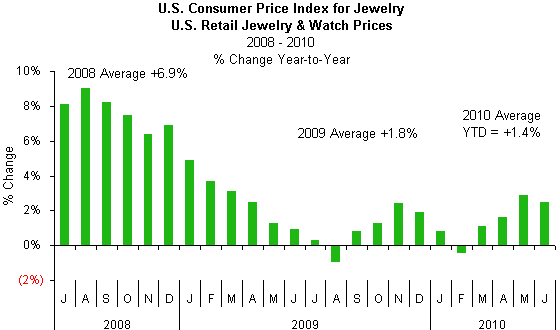 Source: BLS |
The key components of the JCPI – jewelry (only) and watches (only) – reveal great disparity between inflation for these two key segments. Watch prices continue to decline at retail, while jewelry prices are rising slightly faster than the overall JCPI. Watch sales are about 11 percent of total jewelry industry sales, while jewelry of all types represents about 89 percent of total U.S. jewelry sales.
The graph below illustrates inflation among the key components of the JCPI. The green bars are total industry JCPI, while the red bars represent the inflation rate jewelry (only), and the gold bars represent the inflation rate for watches (only).
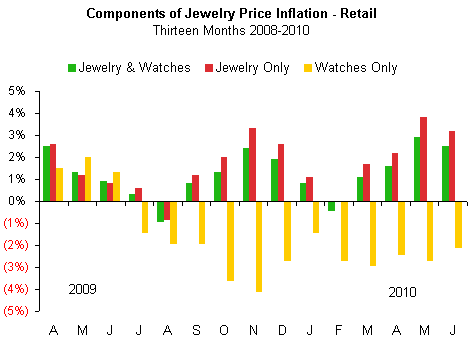
Source: BLS
The Chasm Between Producer and Consumer Jewelry Price Inflation
There is a huge spread between inflation at the jewelry producer level and the jewelry retail store level, as the graph below illustrates.
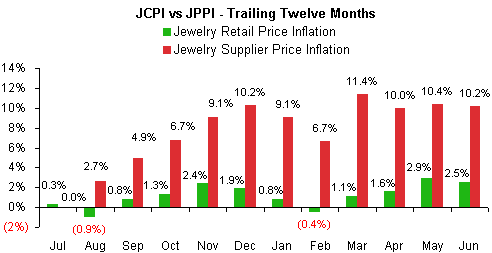
Source: BLS
With sustained solid jewelry sales gains at retail, indicating that shoppers are back in the stores, it is likely that retail jewelers will be able to implement price increases that will not crimp demand just as the party is heating up. However, there is a fine line between the level of price increases which are acceptable to consumers versus what will turn off the spending spigot.